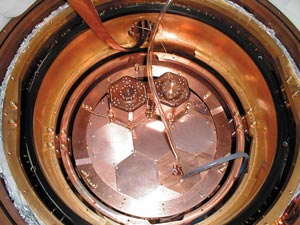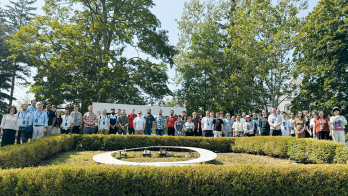
With the first data from their underground observatory in northern Minnesota, the scientists of the Cryogenic Dark Matter Search (CDMS) have peered with greater sensitivity than ever before into the suspected realm of WIMPs, or weakly interacting massive particles. The results show, however, that if they do exist WIMPs are still staying out of sight.
WIMPs are of interest for the two extremes of the very large and the very small. There is strong evidence for large amounts of nonluminous dark matter in the universe, which cannot consist of normal matter (baryons) but seems likely to consist of WIMPs. At the opposite end of the scale supersymmetry yields a range of massive new particles, but the lightest – such as the neutralino – could be stable and therefore a good candidate to be a WIMP.
The CDMS II experiment, which is run by a collaboration of 48 scientists from 13 institutions, plus 28 engineering, technical and administrative staff, is located nearly 780 m below ground in a former iron mine in Soudan, Minnesota. The experiment uses four 250 g germanium detectors and two 100 g silicon detectors, which are cooled to less than 50 mK so that molecular motion becomes negligible. Substantial shielding and the 780 m of rock together reduce the background due to cosmic rays and radioactivity.
The detectors simultaneously measure the ionization and vibration (phonons) produced by particle interactions within the crystals. WIMPs should reveal their presence by creating less ionization than other particles for the same amount of vibration. This is because the WIMPs will scatter from nuclei in the detectors while other particles are more likely to scatter from electrons, and recoiling electrons create more ionization than recoiling nuclei. The timing of the phonons also provides a means of distinguishing between WIMPs and other particles.
The CDMS II results show with 90% certainty that the interaction cross-section for a WIMP with a mass of 60 GeV must be less than 4 x 10-43 cm2, or about one interaction every 25 days per kilogram of germanium (Akerib et al. 2004). This measurement is at least four times more sensitive than the best previous measurement offered by the EDELWEISS experiment in the Fréjus Underground Laboratory in France.
The results, which are described in a paper submitted to Physical Review Letters, were presented at the April Meeting of the American Physical Society on 1-4 May in Denver. The data set the world’s lowest exclusion limits on the cross-section for coherent WIMP-nucleon scalar interactions for all WIMP masses above 15 GeV. They thereby rule out a significant range of neutralino supersymmetric models.
Further reading
D S Akerib et al. (CDMS collaboration) 2004 http://arxiv.org/abs/astro-ph/0405033.








